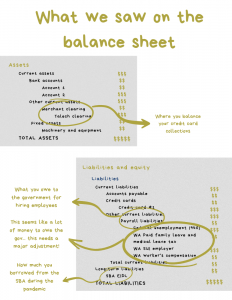Who we worked with
Amanda is passionate about social consciousness, community engagement and contribution. She founded Noskenda, a company whose goal is to run small businesses sustainably while upholding her mission and values. In 2019, Noskenda acquired Perfect Copy and Print, a digital print shop in Capitol Hill. The printshop has been in business for 30 years, and under Amanda’s ownership has grown to offer services from digital printing and graphic design to binding, laminating and more.
Our initial review
Amanda is passionate about equality, social consciousness and community engagement and runs Perfect Copy and Print with those values front and center. When she acquired the Print Shop, she inherited the previous owner’s accounting methods. Amanda hired us to clean up the books and help create a process to make sure the bookkeeping was accurate and up to date.
Here’s what we noticed when we took a closer look:
- The client collected sales through their website, not a typical separate sales system
- Revenue and payroll was recorded on spreadsheets and recorded manually in the books
- We didn’t have access to the website, which meant sales data was sent to us via spreadsheets
- Some transactions were duplicated in the payroll liabilities account and we were unsure of whether or not we owed money
- Transactions in QuickBooks and the bank account didn’t always match up. Some transactions differed by a few cents
- The categorization of transactions was inconsistent and not well organized
What we did
In order to revitalize the books, we started from the beginning.
Step one: 🤔 Review the spreadsheets. We analyzed the client’s spreadsheets so we could understand what was being recorded: revenue? credit cards? payroll? Then we recorded the data from the spreadsheets into the books and matched the numbers to actual cash collected to make sure everything was correct.
Step two: 🔧 Set up automation. We synched the client’s bank accounts to their QuickBooks online and added in automation rules. Once rules were set up, we categorized everything that was left over.
Step three: 👀 Reconcile the bank statement against actual transactions, i.e. double check that all the transactions are there and match the bank statement. We discovered something interesting: for some tax payments, both QuickBooks Payroll and the client’s bank account created transactions that differed from each other by a few cents. Something wasn’t quite adding up.
Step five: ✅ Double check payroll liabilities. We went into QuickBooks online to compare it to the payroll liabilities account. We doublechecked the transactions to verify double accounting and either removed the duplication or adjusted it so the values were deleted (it turns out we didn’t owe money, it was just a typo.)
Step six: ⏩ Create a projection that shows what Amanda can expect in the next six months to a year. This projection was created specifically for her to ensure that it’s easy to use and understand and can provide valuable insight into how Iona is expected to do in the future.
Step seven: 👯 Consult with the client. Here’s where we really get our client onto the same page. We shared our findings, provided advisory, shared our projection, and helped Amanda get her business refreshed and revitalized for the future.
What we saw
Share this article






